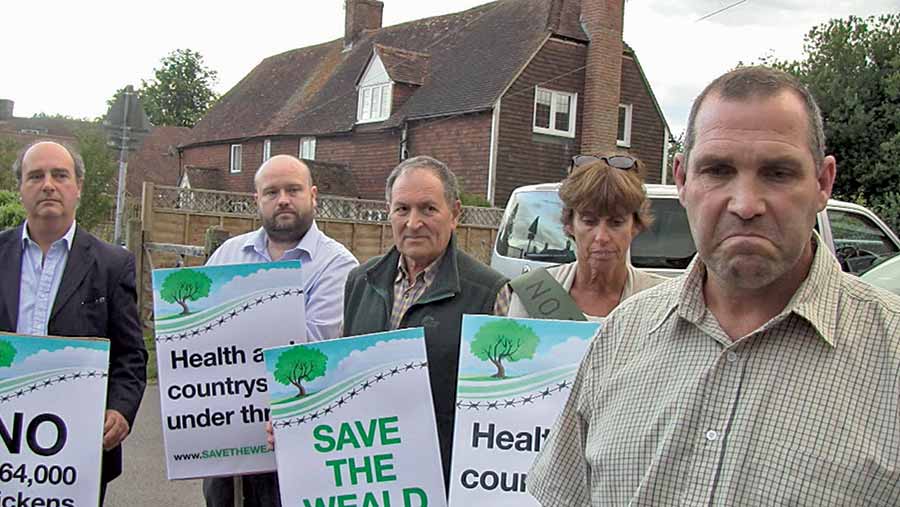Opposition and errors hamper poultry planning applications

Poultry farmers are finding it harder than ever to get planning applications for new buildings through the system.
Local authorities are making too many mistakes in the planning process and are then failing to fight judicial reviews, planning consultants have claimed.
Local pressure groups opposed to such developments are also being invigorated by organisations highlighting the potential animal welfare and human health implications of intensive poultry production.
Agricultural planning consultant Ian Pick said he was aware of five recent applications that had been approved at committee level only to face legal challenges in the High Court, leading local authorities to back down.
See also: Key advice for successful poultry planning
Part of the problem, he said, was that cash-strapped planners were not checking with solicitors or barristers to ensure that they had a water-tight case until they faced Judicial Review.
Elementary mistakes were being made, such as failing to notify local residents or putting incorrect details on the advertisement.
“Rather than fight the cases and incur costs, local authorities are asking the applicants to resubmit, leaving the farmer with having to go through the process all over again.”
Brian Barrow of consultants Acorus agreed that often small technical details were being missed by local authorities and that it was easier and cheaper to have the application resubmitted.
Mr Barrow added that he was concerned by the lack of knowledge among some planners about the need to highlight the EU Environmental Impact Assessments. “We have had a couple of cases where the council has failed to advertise that there was an EIA linked to the application, which in itself has delayed the process.”
Outside influences
Duncan Priestner, NFU poultry board chairman, acknowledged that farmers had a duty to ensure that their applications were on the best possible sites, and that they should keep the local community informed and updated of all developments.
But he was concerned by the interference of outsiders. “We have had cases of people abroad objecting to planning applications, which makes a mockery of an independent system.”
Concerns have also been raised about the way some organisations are whipping up opposition to poultry applications.
The Soil Association has been quite active, though policy director Peter Melchett said the organisation focused on large-scale applications. It had already fought plans for a so-called “mega-dairy” at Nocton in Lincolnshire and a large-scale pig development at Foston in Derbyshire.
In the process, it had collated a great deal of scientific evidence about their potential impact, much of which applied to poultry farms, he said.
Based on this, he has circulated a report in opposition to a number of planned poultry expansions, arguing that the high number of chickens housed in one location may increase the level of disease, posing a threat to the local community.
Lord Melchett claims that antibiotic resistant bacteria from farms can be spread in the air to people living several hundred metres away and can also pass to people in cars when they have to travel behind lorries transporting chickens to abattoirs.
There is also, the Soil Association claims, a considerable risk of contamination of the area with pathogens such as salmonella, campylobacter, MRSA and E coli.
Research suggests that, within a certain distance of poultry sheds, there are likely to be emissions such as ammonia and bio-aerosols in concentrations that are potentially harmful to human health.
Lord Melchett has used this evidence to oppose plans put forward by egg packer Fridays for a 64,000-bird unit at Horsmonden in Kent, and against the Newcome-Baker Farms proposal for four new broiler sheds at Sedgeford in Norfolk.
Lord Melchett believes it is fair to use this evidence in consultation responses. “Indeed it would be both unfair and unprofessional not to make scientific evidence which we have collated as a public interest charity available to the public,” he told Poultry World.
“Research from other EU countries and indeed from the US, where intensive, indoor livestock farming has been in place for longer than in Europe, is both relevant and can provide an early warning of problems we are likely to face in the UK if we follow a similar pattern of development.”
Scaremongering
However, Mr Barrow suggested the additional information was actually doing the local community a disservice.
“What all this does is cloud the democratic process to some extent,” he said. “People are absolutely entitled to have a view in their area on how an application will affect vehicle movements on their roads, but some of the information being put forward is scaremongering and over the top.”
For example, a local opposition group has been set up in relation to the Sedgeford application, which has printed and distributed thousands of leaflets to local villages including a photo of an unscreened poultry farm three times larger than the one proposed and 10,000 miles away in Australia.
Lord Melchett said that whether the association’s input was helpful or unhelpful to local communities was for residents to say. “In all cases where we have been involved in objecting to a planning application, we have only done so with the support and encouragement of local people.”
